change time MITSUBISHI MIRAGE G4 2020 (in English) Owner's Guide
[x] Cancel search | Manufacturer: MITSUBISHI, Model Year: 2020, Model line: MIRAGE G4, Model: MITSUBISHI MIRAGE G4 2020Pages: 253, PDF Size: 36.39 MB
Page 190 of 253
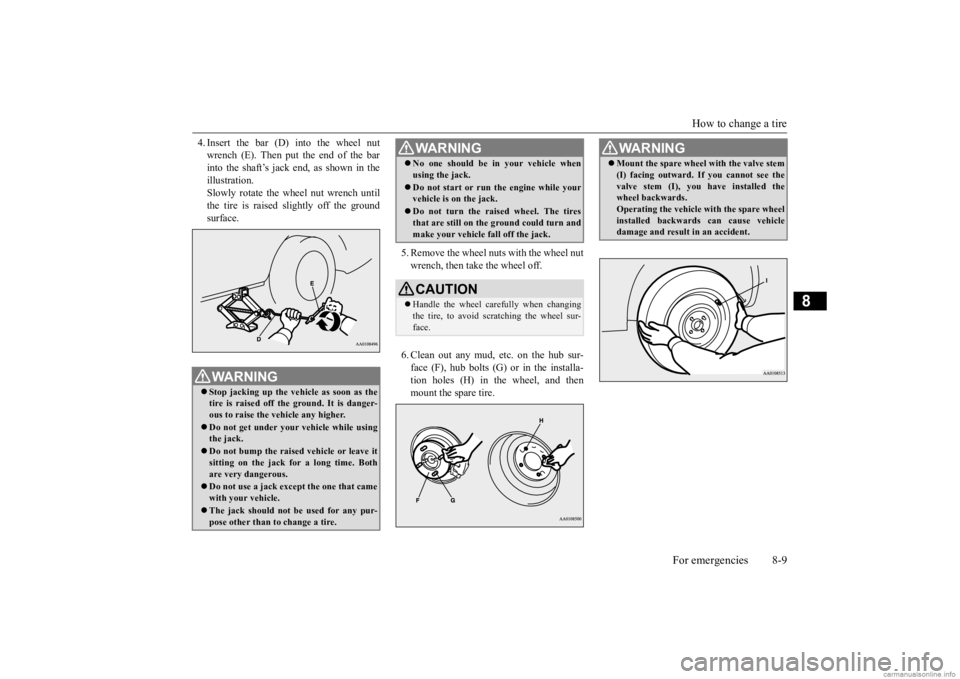
How to change a tire
For emergencies 8-9
8
4. Insert the bar (D) into the wheel nut wrench (E). Then put the end of the barinto the shaft’s jack end, as shown in the illustration. Slowly rotate the wheel nut wrench untilthe tire is raised
slightly off the ground
surface.
5. Remove the wheel nuts with the wheel nut wrench, then take the wheel off. 6. Clean out any mud, etc. on the hub sur- face (F), hub bolts (G)
or in the installa-
tion holes (H) in the wheel, and then mount the spare tire.
WA R N I N G Stop jacking up the ve
hicle as soon as the
tire is raised off the ground. It is danger- ous to raise the ve
hicle any higher.
Do not get under your vehicle while using the jack. Do not bump the raised
vehicle or leave it
sitting on the jack for a long time. Bothare very dangerous. Do not use a jack except the one that came with your vehicle. The jack should not be used for any pur- pose other than to change a tire.
No one should be
in your vehicle when
using the jack. Do not start or run the engine while your vehicle is on the jack. Do not turn the raised wheel. The tires that are still on the
ground could turn and
make your vehicle fall off the jack.CAUTION Handle the wheel care
fully when changing
the tire, to avoid scratching the wheel sur-face.WA R N I N G
WA R N I N G Mount the spare wheel
with the valve stem
(I) facing outward. If
you cannot see the
valve stem (I), you
have installed the
wheel backwards. Operating the vehicle with the spare wheel installed backwards can cause vehicledamage and result
in an accident.
BK0284300US.book 9 ページ 2019年5月23日 木曜日 午後12時22分
Page 204 of 253
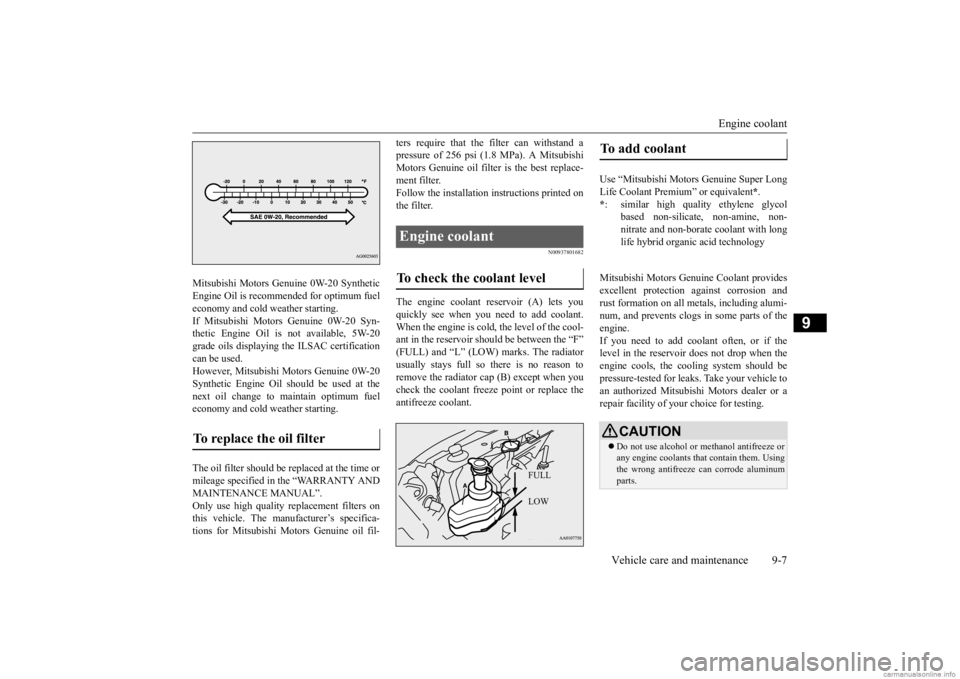
Engine coolant
Vehicle care and maintenance 9-7
9
Mitsubishi Motors Genui
ne 0W-20 Synthetic
Engine Oil is recommended for optimum fueleconomy and cold weather starting. If Mitsubishi Motors Genuine 0W-20 Syn- thetic Engine Oil is not available, 5W-20grade oils displaying th
e ILSAC certification
can be used. However, Mitsubishi Motors Genuine 0W-20Synthetic Engine Oil s
hould be used at the
next oil change to maintain optimum fuel economy and cold weather starting. The oil filter should be replaced at the time or mileage specified in the “WARRANTY ANDMAINTENANCE MANUAL”. Only use high quality
replacement filters on
this vehicle. The manufacturer’s specifica-tions for Mitsubishi Mo
tors Genuine oil fil-
ters require that the filter can withstand a pressure of 256 psi (1.8 MPa). A MitsubishiMotors Genuine oil filter
is the best replace-
ment filter. Follow the installation instructions printed onthe filter.
N00937801682
The engine coolant reservoir (A) lets youquickly see when you need to add coolant. When the engine is cold
, the level of the cool-
ant in the reservoir should be between the “F”(FULL) and “L” (LOW) marks. The radiator usually stays full so there is no reason to remove the radiator cap (B) except when youcheck the coolant freeze point or replace the antifreeze coolant.
Mitsubishi Motors Genuine Coolant provides excellent protection
against corrosion and
rust formation on all me
tals, including alumi-
num, and prevents clogs in some parts of theengine. If you need to add coolant often, or if the level in the reservoir does not drop when theengine cools, the c
ooling system should be
pressure-tested for leaks. Take your vehicle to an authorized Mitsubishi Motors dealer or arepair facility of your
choice for testing.
To replace the oil filter
Engine coolant To check the coolant level
FULL LOW
To add coolant Use “Mitsubishi Motors
Genuine Super Long
Life Coolant Premium” or equivalent
*.
* : similar high quality
ethylene glycol
based non-silicate
, non-amine, non-
nitrate and non-borate coolant with long life hybrid organic acid technologyCAUTION Do not use alcohol or
methanol antifreeze or
any engine coolants th
at contain them. Using
the wrong antifreeze can corrode aluminum parts.
BK0284300US.book 7 ページ 2019年5月23日 木曜日 午後12時22分
Page 214 of 253
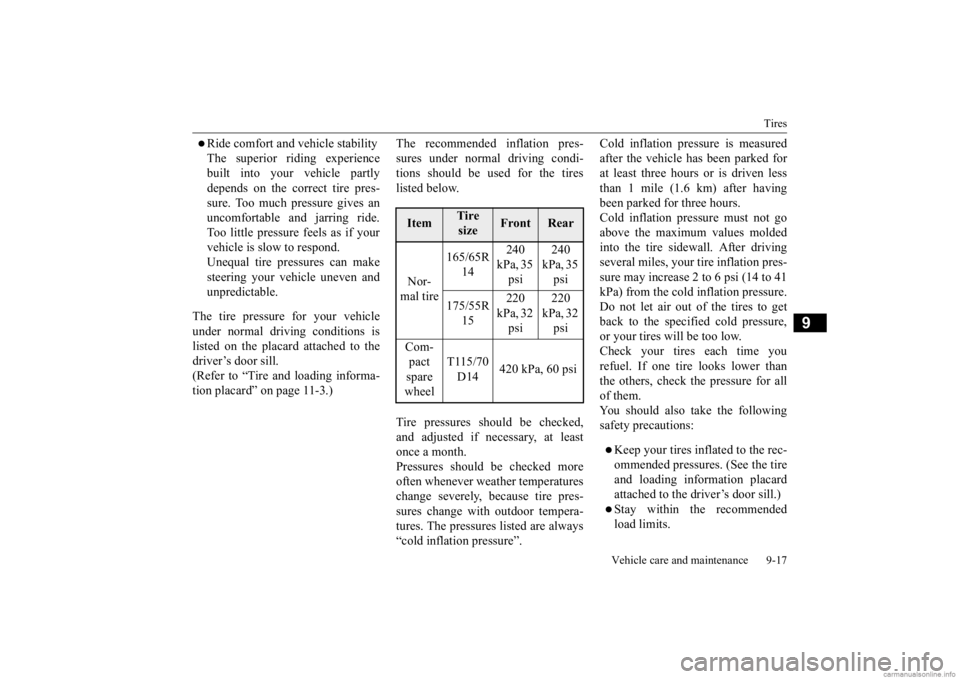
Tires
Vehicle care and maintenance 9-17
9
Ride comfort and vehicle stability The superior riding experience built into your vehicle partly depends on the correct tire pres-sure. Too much pressure gives an uncomfortable and jarring ride. Too little pressure feels as if yourvehicle is slow to respond. Unequal tire pressures can make steering your vehicle uneven andunpredictable.
The tire pressure for your vehicle under normal driving conditions is listed on the placard attached to the driver’s door sill.(Refer to “Tire and loading informa- tion placard” on page 11-3.)
The recommended inflation pres- sures under normal driving condi- tions should be used for the tires listed below. Tire pressures should be checked, and adjusted if necessary, at least once a month.Pressures should be checked more often whenever weather temperatures change severely, because tire pres-sures change with outdoor tempera- tures. The pressures listed are always “cold inflation pressure”.
Cold inflation pressure is measured after the vehicle has been parked for at least three hours or is driven less than 1 mile (1.6 km) after havingbeen parked for three hours. Cold inflation pres
sure must not go
above the maximum values moldedinto the tire sidewall. After driving several miles, your tire inflation pres- sure may increase 2 to 6 psi (14 to 41kPa) from the cold inflation pressure. Do not let air out of the tires to get back to the specified cold pressure,or your tires will be too low. Check your tires each time you refuel. If one tire looks lower thanthe others, check the pressure for all of them. You should also take the followingsafety precautions:Keep your tires inflated to the rec-ommended pressures. (See the tireand loading information placard attached to the driver’s door sill.)Stay within the recommended load limits.
Item
Tire size
Front
Rear
Nor- mal tire
165/65R
14
240 kPa, 35
psi
240 kPa, 35
psi
175/55R
15
220 kPa, 32
psi
220 kPa, 32
psi
Com- pact spare wheel
T115/70 D14
420 kPa, 60 psi
BK0284300US.book 17 ページ 2019年5月23日 木曜日 午後12時22分
Page 219 of 253
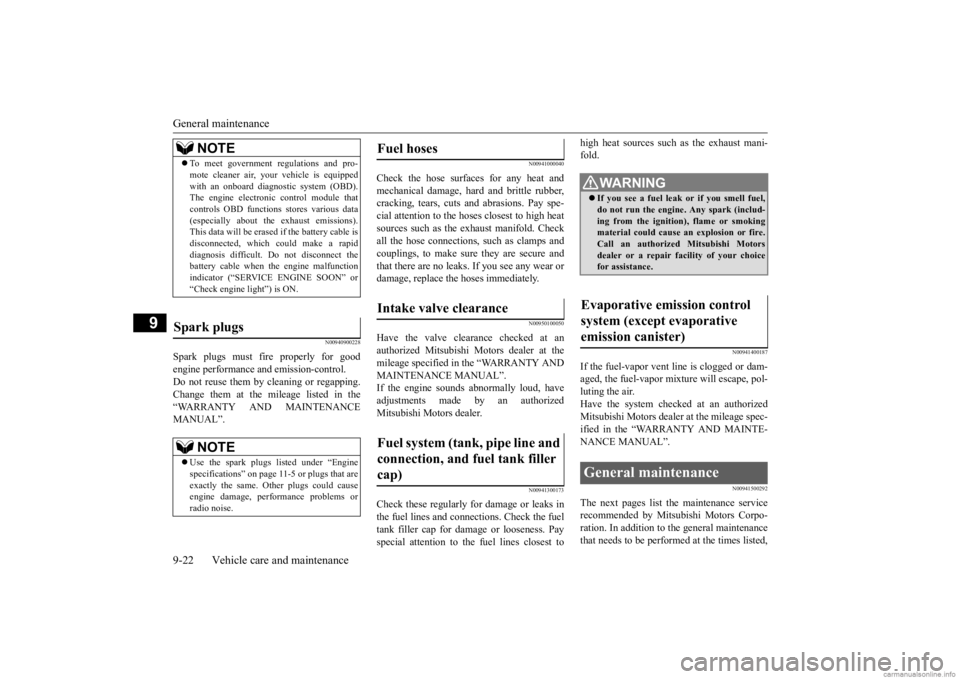
General maintenance 9-22 Vehicle care and maintenance
9
N00940900228
Spark plugs must fire properly for good engine performance
and emission-control.
Do not reuse them by cleaning or regapping.Change them at the mileage listed in the “WARRANTY AND MAINTENANCE MANUAL”.
N00941000040
Check the hose surfaces for any heat and mechanical damage, hard and brittle rubber, cracking, tears, cuts and abrasions. Pay spe-cial attention to the hos
es closest to high heat
sources such as the exhaust manifold. Check all the hose connections
, such as clamps and
couplings, to make sure
they are secure and
that there are no leaks. If you see any wear or damage, replace the
hoses immediately.
N00950100050
Have the valve clearance checked at an authorized Mitsubishi Motors dealer at the mileage specified in the “WARRANTY AND MAINTENANCE MANUAL”.If the engine sounds abnormally loud, have adjustments made by an authorized Mitsubishi Motors dealer.
N00941300173
Check these regularly for damage or leaks in the fuel lines and connections. Check the fuel tank filler cap for dama
ge or looseness. Pay
special attention to the fuel lines closest to
high heat sources such
as the exhaust mani-
fold.
N00941400187
If the fuel-vapor vent line is clogged or dam-aged, the fuel-vapor mixture will escape, pol- luting the air. Have the system checked at an authorizedMitsubishi Motors dealer at the mileage spec- ified in the “WARRANTY AND MAINTE- NANCE MANUAL”.
N00941500292
The next pages list th
e maintenance service
recommended by Mitsubishi Motors Corpo-ration. In addition to the general maintenance that needs to be performed at the times listed,
NOTE
To meet government regulations and pro- mote cleaner air, your
vehicle is equipped
with an onboard dia
gnostic system (OBD).
The engine electronic control module that controls OBD functions stores various data (especially about th
e exhaust emissions).
This data will be erased if the battery cable is disconnected, which could make a rapid diagnosis difficult.
Do not disconnect the
battery cable when the engine malfunction indicator (“SERVICE ENGINE SOON” or “Check engine
light”) is ON.
Spark plugs
NOTE
Use the spark plugs listed under “Engine specifications” on page 11
-5 or plugs that are
exactly the same. Other plugs could cause engine damage, performance problems orradio noise.
Fuel hoses Intake valve clearance Fuel system (tank, pipe line and connection, and fuel tank filler cap)
WA R N I N G If you see a fuel leak
or if you smell fuel,
do not run the engine. Any spark (includ- ing from the ignition
), flame or smoking
material could cause an explosion or fire.Call an authorized Mitsubishi Motors dealer or a repair fa
cility of your choice
for assistance.
Evaporative emission control system (except evaporative emission canister) General maintenance
BK0284300US.book 22 ページ 2019年5月23日 木曜日 午後12時22分
Page 220 of 253
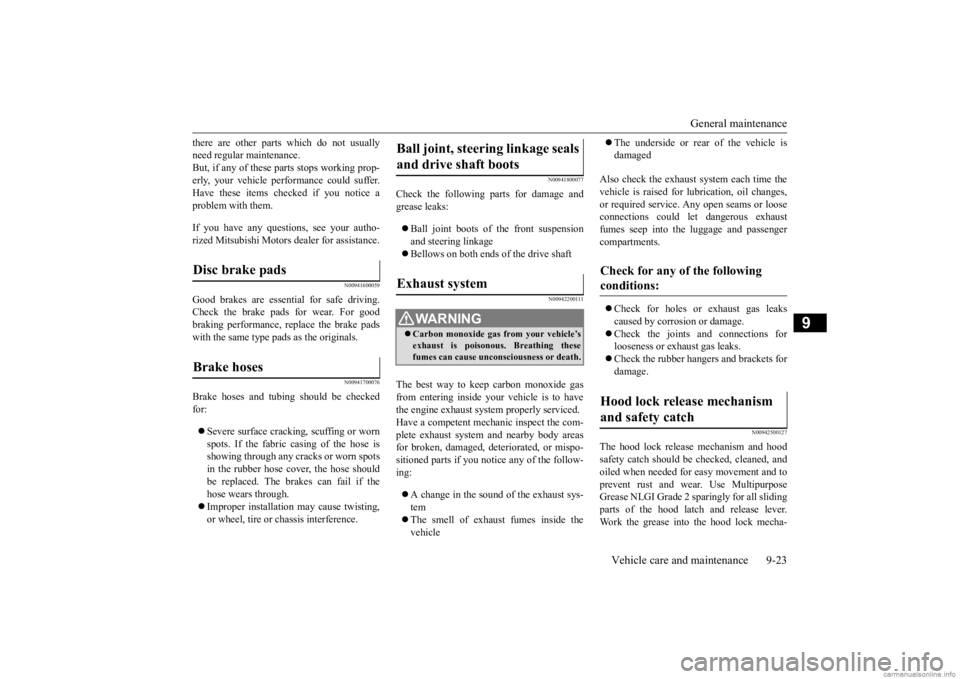
General maintenance
Vehicle care and maintenance 9-23
9
there are other parts which do not usually need regular maintenance.But, if any of these
parts stops working prop-
erly, your vehicle performance could suffer. Have these items checked if you notice aproblem with them. If you have any questions, see your autho- rized Mitsubishi Motors dealer for assistance.
N00941600059
Good brakes are essential for safe driving. Check the brake pads for wear. For goodbraking performance, replace the brake pads with the same type pa
ds as the originals.
N00941700076
Brake hoses and tubing should be checked for: Severe surface cracki
ng, scuffing or worn
spots. If the fabric casing of the hose isshowing through any cracks or worn spots in the rubber hose cover, the hose should be replaced. The brakes can fail if thehose wears through. Improper installation
may cause twisting,
or wheel, tire or
chassis interference.
N00941800077
Check the following parts for damage and grease leaks: Ball joint boots of the front suspension and steering linkage Bellows on both ends of the drive shaft
N00942200111
The best way to keep carbon monoxide gas from entering inside your
vehicle is to have
the engine exhaust syst
em properly serviced.
Have a competent mechanic inspect the com- plete exhaust system
and nearby body areas
for broken, damaged, deteriorated, or mispo- sitioned parts if you no
tice any of the follow-
ing: A change in the sound of the exhaust sys- tem The smell of exhaust fumes inside the vehicle
The underside or rear of the vehicle is damaged
Also check the exhaust system each time the vehicle is raised for l
ubrication, oil changes,
or required service. A
ny open seams or loose
connections could le
t dangerous exhaust
fumes seep into the luggage and passenger compartments. Check for holes or exhaust gas leaks caused by corrosion or damage. Check the joints and connections for looseness or exhaust gas leaks. Check the rubber hangers and brackets for damage.
N00942500127
The hood lock release mechanism and hood safety catch should be
checked, cleaned, and
oiled when needed for easy movement and to prevent rust and wear. Use Multipurpose Grease NLGI Grade 2 sp
aringly for all sliding
parts of the hood latc
h and release lever.
Work the grease into the hood lock mecha-
Disc brake pads Brake hoses
Ball joint, steering linkage seals and drive shaft boots Exhaust system
WA R N I N G Carbon monoxide gas
from your vehicle’s
exhaust is poisonous. Breathing thesefumes can cause unconsciousness or death.
Check for any of the following conditions: Hood lock release mechanism and safety catch
BK0284300US.book 23 ページ 2019年5月23日 木曜日 午後12時22分